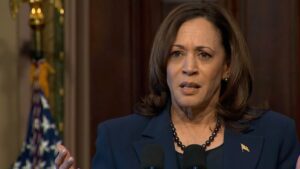Kamala Harris has taken a bold stance in advocating for a federal minimum wage increase to $15 per hour, a policy intended to benefit low-income Americans by giving them a “living wage.” However, beneath the promise lies a series of economic implications—some predictable, others less so—that could leave Americans with unintended consequences like inflation, job cuts, and business closures. Rather than doubling wages for entry-level positions, why not consider solutions that build skill sets, enabling workers to move beyond minimum-wage jobs and pursue stable, well-paid careers?
 How Many People Benefit from a Federal Minimum Wage Increase?
How Many People Benefit from a Federal Minimum Wage Increase?
The Congressional Budget Office (CBO) estimates that about 17 million workers would directly benefit if the federal minimum wage were raised to $15 per hour, with another 10 million potentially experiencing “ripple effect” increases as businesses adjust their wage structures to maintain pay equity. However, this benefit comes with underlying issues. Doubling wages may improve hourly income for these workers, but it may not enhance their long-term economic stability if price inflation erodes their increased purchasing power.
Moreover, most minimum-wage jobs were originally designed as stepping stones for young or inexperienced workers entering the workforce, not as positions to support families long-term. Today, rather than inflating wages for entry-level positions, wouldn’t it be more effective to equip workers with marketable skills through vocational training? This approach offers a sustainable solution that allows people to climb the career ladder, increasing their earning potential without risking economic strain.
Hidden Costs: Will Higher Wages Mean Higher Prices for Everyone?
When labor costs account for 50% to 70% of the cost of sales (COS), a federal minimum wage increase inevitably impacts the entire supply chain. This rise in expenses can drive up the cost of goods and services, affecting everyone’s budget—from groceries to home essentials to dining out. Businesses, particularly in sectors like retail, hospitality, and manufacturing, may not have the profit margins to absorb such a sharp increase in expenses, even if they’re large corporations. And for smaller businesses, absorbing these costs is hardly an option.
So, who ends up paying for the wage increase? Consumers. Price hikes follow as businesses adjust to cover their bottom line. Although a higher minimum wage sounds appealing on paper, it could ultimately lead to a reduction in purchasing power if the increased wages are offset by inflation—a situation where everyone loses.
Small Businesses Under Pressure: How Will They Survive?
Small businesses, which employ roughly 47% of the American workforce, face an uncertain future if a minimum wage hike is mandated. Unlike large corporations, which may have some leeway to absorb labor costs, small businesses often operate on slim margins and cannot afford to double their wage expenses. Proponents of a federal minimum wage increase argue that tax breaks and other concessions for small businesses can help ease the burden, but these temporary measures are not long-term solutions.
In practice, small businesses may have to resort to cutting hours, reducing hiring, or raising prices just to stay afloat. And if even these measures aren’t enough, some businesses might close altogether, particularly in rural or low-income communities that rely heavily on local commerce. This means fewer job opportunities, reduced economic mobility, and potentially an increase in small business closures—hardly the intended outcome of a policy meant to “help” workers.
Automation: The Unseen Consequence of Wage Increases
One of the most overlooked consequences of raising the minimum wage is that it encourages automation. As labor costs climb, many businesses will consider investing in technology to reduce dependence on human labor. In recent years, industries from fast food to retail to logistics have experimented with automation to manage operational costs. With rising labor costs, this trend is likely to accelerate.
Self-checkout kiosks, robotic food preparation, and automated warehouse systems are just a few examples of how technology could replace minimum-wage jobs. For workers whose positions are replaced by automation, the minimum wage increase is a moot point; they are left without a job. A 2021 report by the Brookings Institution predicted that automation would disproportionately impact workers in low-wage jobs, such as food service and retail. Raising the wage to $15 an hour could accelerate this shift, leaving millions unemployed and dependent on government support.
Inflation: An Economic Domino Effect
If minimum wage increases lead to price hikes, inflation is almost inevitable. The resulting higher cost of goods and services doesn’t just impact minimum-wage workers; it affects everyone. For middle- and lower-income families, the rising cost of living can be especially burdensome. And since inflation tends to rise faster than wages, the potential benefits of a wage increase could evaporate as expenses climb, leaving workers in the same financial position as before or even worse off.
Proponents of a federal minimum wage increase argue that low-income families need a living wage to thrive. However, if inflation climbs in response to higher wages, the benefit is likely to be short-lived. Instead of promoting economic growth, an inflated minimum wage risks eroding the purchasing power of wage earners across all income brackets.
Government Subsidies: Short-Term Fixes with Long-Term Consequences
To counteract inflation and ease the burden of rising living costs, Harris and other advocates propose increased government subsidies for essentials like housing, food, and healthcare. However, this approach is fraught with issues. Subsidies require funding, which could come from either tax increases or by printing more money—both options with significant economic implications.
Taxing businesses and high earners might sound reasonable, but it reduces funds available for business expansion, hiring, and wages. Alternatively, printing more money risks inflationary pressure, further raising the cost of living. These subsidies might help low-income families in the short term, but they create dependency rather than fostering independence. Instead, a long-term solution, like investing in skills development and vocational training, would create sustainable change without adding to the national debt or inflation.
Higher Interest Rates and the Risk of Recession
The Federal Reserve has already raised interest rates in response to recent inflation, and a federal minimum wage increase could lead to even higher rates. If inflation rises again due to wage increases, the Fed may continue to increase interest rates to stabilize prices. However, this strategy has a ripple effect: higher interest rates slow down spending, borrowing, and investment, which could tip the economy into recession.
Americans are still feeling the impact of recent rate hikes, which have made mortgages, credit cards, and car loans more expensive. A wage hike that triggers further rate increases could push the economy toward recession, affecting job growth and investment in all sectors.
Training Programs: A Practical Solution for Economic Mobility
So, if raising the minimum wage carries so many risks, what’s the alternative? One solution lies in vocational training and skills development. Programs that teach practical skills for well-paying fields, such as healthcare, construction, and technology, can offer long-term benefits for workers, equipping them for careers that pay well above minimum wage. This approach also supports economic mobility and growth, reducing reliance on entry-level jobs and creating more high-quality positions.
Investing in skill-building programs, rather than short-term wage increases, allows workers to develop expertise in fields with high demand and good pay. For example, fields like electrical work, plumbing, and coding all offer substantial wages without requiring a college degree. By empowering workers with skills, the economy grows without risking inflation, job cuts, or unsustainable government spending.
Conclusion: A Sustainable Path to Economic Growth
While raising the federal minimum wage to $15 per hour may appear to be a quick fix, it risks long-term harm to the economy. From price inflation and increased unemployment to the strain on small businesses, the policy comes with considerable trade-offs. Rather than relying on wage mandates and government subsidies, we should consider investing in skill-building programs that empower workers to transition out of entry-level jobs into meaningful, high-paying careers.
In the end, building a self-sufficient workforce is not just better for individual workers; it’s better for America’s economy. A federal minimum wage increase may benefit some in the short term, but a skilled, independent workforce offers a far more sustainable and prosperous future for all Americans.
References:
- Congressional Budget Office. (2021). The Effects on Employment and Family Income of Increasing the Federal Minimum Wage. Retrieved from https://www.cbo.gov/publication/56975
- U.S. Small Business Administration. Small Business GDP: 1998–2014. Retrieved from https://www.sba.gov/advocacy/small-business-gdp-1998-2014
- Brookings Institution. (2021). Automation and Artificial Intelligence: How machines are affecting people and places. Retrieved from https://www.brookings.edu/research/automation-and-artificial-intelligence-how-machines-affect-people-and-places/




 Taking on Big Pharma and Insurance Companies: A Hollow Victory?
Taking on Big Pharma and Insurance Companies: A Hollow Victory?


 The key elements of the Harris-Walz tax plan are designed around restoring and expanding two major tax credits: the Child Tax Credit (CTC) and the Earned Income Tax Credit (EITC). Additionally, they aim to raise taxes on high earners and corporations by rolling back Trump-era tax cuts and increasing capital gains taxes for wealthier Americans. Specifically, the Harris-Walz plan proposes to:
The key elements of the Harris-Walz tax plan are designed around restoring and expanding two major tax credits: the Child Tax Credit (CTC) and the Earned Income Tax Credit (EITC). Additionally, they aim to raise taxes on high earners and corporations by rolling back Trump-era tax cuts and increasing capital gains taxes for wealthier Americans. Specifically, the Harris-Walz plan proposes to:
